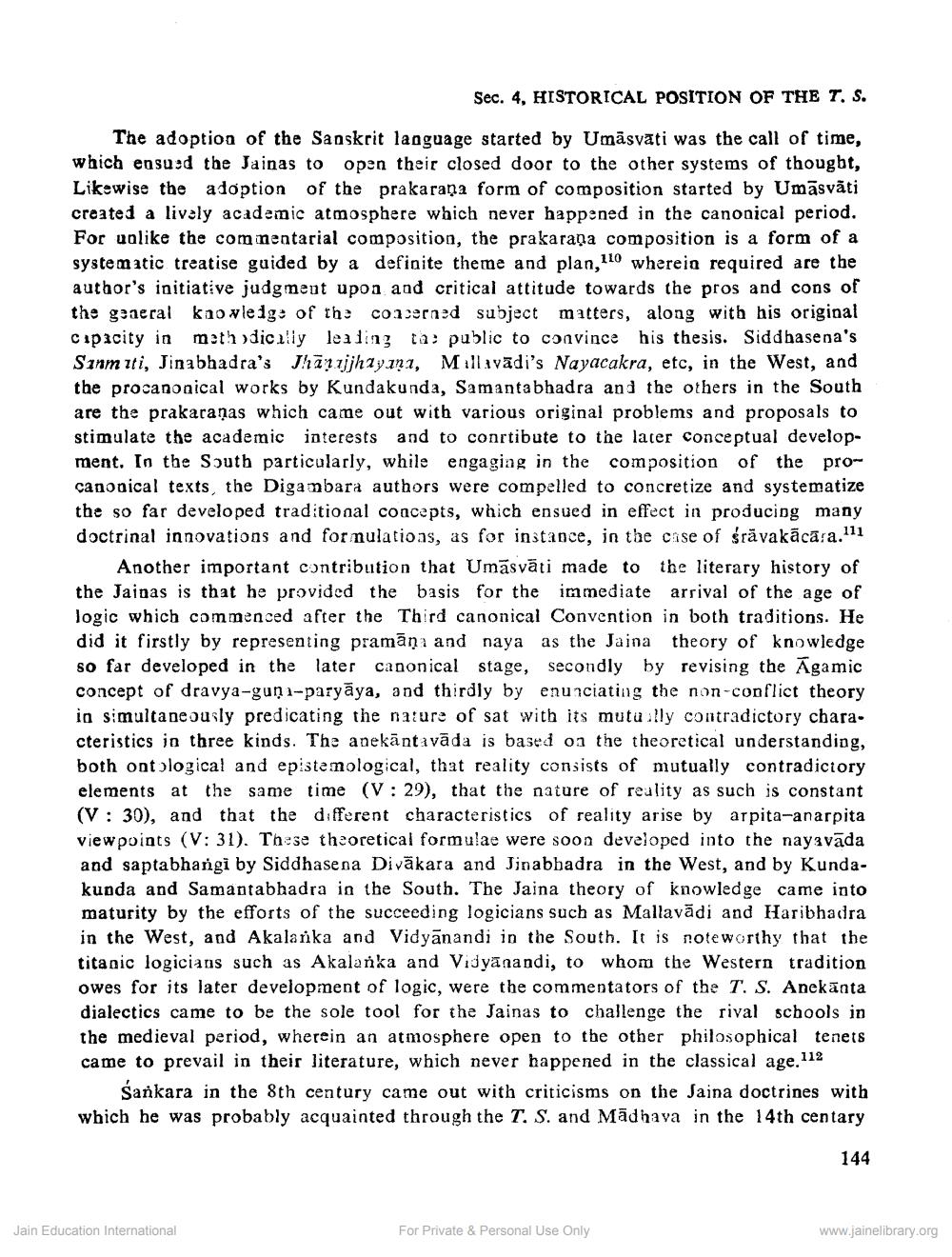________________
Sec. 4, HISTORICAL POSITION OF THE T. S.
The adoption of the Sanskrit language started by Umāsvati was the call of time, which ensu:d the Jainas to open their closed door to the other systems of thought, Likewise the adoption of the prakaraņa form of composition started by Umāsvāti created a lively academic atmosphere which never happened in the canonical period. For uolike the commentarial composition, the prakarana composition is a form of a system atic treatise guided by a definite theme and plan,10 whereia required are the author's initiative judgment upon and critical attitude towards the pros and cons of the geaeral knowledge of the concerned subject matters, along with his original capacity in mathdically leading ta: public to convince his thesis. Siddhasena's Sinm iti, Jinabhadra's Jhānijjhzyını, Millavādi's Nayacakra, etc, in the West, and the procanonical works by Kundakunda, Samantabhadra and the others in the South are the prakaranas which came out with various original problems and proposals to stimulate the academic interests and to conrtibute to the later conceptual development. In the South particularly, while engaging in the composition of the procanonical texts, the Digambara authors were compelled to concretize and systematize the so far developed traditional concepts, which ensued in effect in producing many doctrinal innovations and formulations, as for instance, in the case of $rävakācāra.111
Another important contribution that Umāsvāti made to the literary history of the Jainas is that he provided the basis for the immediate arrival of the age of logic which commenced after the Third canonical Convention in both traditions. He did it firstly by representing pramāņa and naya as the Jaina theory of knowledge so far developed in the later canonical stage, secondly by revising the Agamic concept of dravya-guna-paryāya, and thirdly by enunciating the non-conflict theory in simultaneously predicating the nature of sat with its mutually contradictory chara. cteristics in three kinds. The anekāntavāda is based on the theoretical understanding, both ontological and epistemological, that reality consists of mutually contradictory elements at the same time (V: 29), that the nature of reality as such is constant (V: 30), and that the different characteristics of reality arise by arpita-anarpita viewpoints (V: 31). These theoretical formulae were soon developed into the nayavāda and saptabhangi by Siddhasena Divākara and Jinabbadra in the West, and by Kundakunda and Samantabhadra in the South. The Jaina theory of knowledge came into maturity by the efforts of the succeeding logicians such as Mallavādi and Haribhadra in the West, and Akalarika and Vidyānandi in the South. It is noteworthy that the titanic logicians such as Akalanka and Vidyānandi, to whom the Western tradition owes for its later development of logic, were the commentators of the T. S. Anekānta dialectics came to be the sole tool for the Jainas to challenge the rival schools in the medieval period, wherein an atmosphere open to the other philosophical tenets came to prevail in their literature, which never happened in the classical age. 112
Sankara in the 8th century came out with criticisms on the Jaina doctrines with which he was probably acquainted through the T. S. and Mādhava in the 14th centary
144
Jain Education International
For Private & Personal Use Only
www.jainelibrary.org




